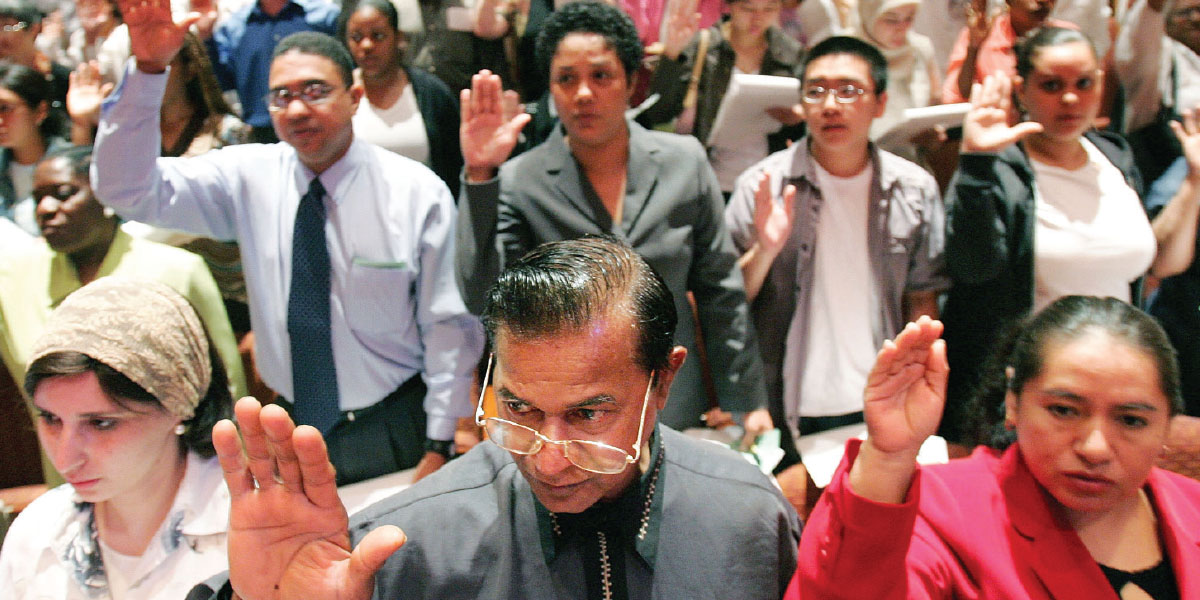Decade after decade, the number of international students in the United States has increased significantly. While fewer than 50,000 international students enrolled in U.S. higher education institutions in 1960, their numbers had more than doubled by 1970 and doubled again—and then some—by 1980, according to the Institute of International Education (IIE), a nonprofit organization in New York.
By the 2011–12 academic year, nearly 765,000 students—representing 3.7 percent of enrollment at U.S. institutions—came from other countries. That all-time high reflects a dramatic expansion in the overall pool of students choosing to pursue a degree abroad.
“In 1980, about 1 million students studied internationally. Now, that number is up to almost 5 million—and that global market has an estimated worth of around $100 billion,” observes Richard Everitt, director of education at the Washington, D.C., office of the British Council, the United Kingdom’s educational and cultural relations agency. “Despite the recession, we’ve seen an increase, year on year, of international students demanding training for themselves.”
Many students view such international training as essential to employability. “Education must be global because careers in the 21st century will be global,” notes Peggy Blumenthal, senior counselor to the president of IIE. “International experience matters whether you stay in your home country and work for a company that sells all over the world, or you work in another country, or you work with partners around the world to develop products or deliver services.”
In other words, globalization leads to mobilization: More students are on the move, looking for the educational opportunities and experiences that translate into the qualifications desired by employers. Yet even as the pie of international students has grown larger, the U.S. slice has gotten smaller. As noted in IIE’s Project Atlas: Trends and Global Data 2012 report, the United States now hosts 19 percent of the students who study abroad annually, down from 28 percent a decade earlier.
Not Always Easy
What’s behind that 32 percent reduction in U.S. market share? Certainly, the 2001 terrorist attacks on American soil have had a lingering effect.
“International enrollment really slowed down after 9/11, when Americans were nervous about safety and it became problematic for students from other countries to obtain visas,” recalls Gary Rhodes, director of the Center for Global Education, housed at the UCLA Graduate School of Education and Information Studies. From 2003 to 2006, IIE data show that U.S. institutions experienced an unprecedented three-year decline in international students.
Although the numbers have been on the upswing since 2007, “The federal authorities remain vigilant about enforcing every aspect of immigration law. For example, if a spouse accompanies an international student to the United States and is caught working, the spouse can—and probably will—be deported,” says Vic Johnson, senior adviser for public policy at NAFSA: Association of International Educators, Washington, D.C.
Most students can remain in the United States for one year after graduation, provided they find a job related to their degree and thus qualify for a work permit. The recent recession, however, has hindered employment opportunities. Another obstacle is the affordability of a U.S. education. Just as domestic students and parents increasingly question the cost/value relationship of attending a particular U.S. institution, so do their counterparts in other countries.
“The cost of U.S. higher education in general is perceived to be high, given the structure and approach we have,” notes Rahul Choudaha, director of research and strategic development for World Education Services, a New York–based nonprofit organization. “The high costs in terms of dollars make the perception of long-term value more difficult, especially for students seeking undergraduate degrees.”
Above all, the decline in U.S. market share relates to the emergence of new education destinations. Students who once might have considered only U.S. institutions now have myriad choices—and many of those options are much closer to home.
More Players in the Game
Particularly within the last decade, the number of countries wanting to host both undergraduate and graduate international students has grown significantly. In addition to other traditional host countries—the United Kingdom, Canada, Australia, and New Zealand—the United States now competes with nations that have historically provided students. China, for instance, still sends more students abroad than any other country, but it has also launched several initiatives to build its higher education capacity and attract more international students itself.
“You also have South Korea, Singapore, Malaysia, and Thailand all positioning themselves as regional education hubs. And, in the Middle East, countries such as United Arab Emirates and Qatar are allocating land and funds to set up branch campuses of well-known institutions, to serve not only their own students but also students in the region,” says Blumenthal.
The concept of regional education hubs, a relatively recent development, is largely the product of government policies, strategies, and funding directed toward long-term economic development. Providing higher education offers these countries a means to build their international reputations, attract investment from abroad, and retain more homegrown talent.
From the student perspective, regional hubs also have a cultural comfort factor. Malaysia, for example, has a large Muslim population. “That might make Malaysia an attractive place for Muslims from the Middle East. They may find Malaysia more appealing than a Western country because it’s conservative—for example, we don’t have alcohol on campus,” says Anthony Cunningham, dean of Perdana University/Royal College of Surgeons in Ireland School of Medicine in Malaysia. Similarly, he says, a significant proportion of the Malaysian population is Chinese, so students from China would feel at home with much of the country’s food and culture.
The newest entrants into global higher education, clustered primarily in Asia, will exert a noticeable influence on the market, believes Beatrix Li. Now international program manager for Johns Hopkins University’s Center for Talented Youth, she previously served as admissions manager at the University of Hong Kong.
“Now that the Chinese economy is growing strong and universities in Asia are promoting increasingly, it diversifies student mobility significantly,” says Li. “Three to four years ago, the mobility was unilateral, from East to West, and more specifically to the UK and U.S. Now that other countries have entered the race, the mobility will become bidirectional or even multidirectional in the future.”
Changes Boost Numbers
Having worked in international recruitment and admissions for 17 years, Jill Stoffers thinks the U.S. share of the education market will continue to decline. “Canada, Australia, Hong Kong, and Singapore have all gotten a taste for more students and have figured out what they can do better than American universities—which is to have a coordinated immigration strategy and to make education cheaper,” says Stoffers, executive director of enrollment management for the Monterey Institute of International Studies, a graduate school of Vermont’s Middlebury College that is located in Monterey, California.
Canada, for instance, has expanded its postgraduation work permits to three years and made it easier for international students to achieve immigrant status. A student who graduates from a Canadian postsecondary institution can now apply for permanent residency after working for one year in the country, rather than the two years required previously—and on-campus work as a researcher counts.
“At the federal level, we have had a big upswing in interest in international students,” says Jennifer Humphries, vice president of membership, public policy, and communications for the Canadian Bureau for International Education, Ottawa. The Canadian government has rolled out a national brand for promoting its universities, colleges, and schools (Imagine: Education in Canada) and recently allocated $10 million (Canadian dollars) to be spent over the next two years on marketing the country as an education destination. Another $13 million (Canadian dollars) was allocated to support a program that arranges internships in Canada for international students.
International students at all levels have definitely noticed: Their numbers in Canada grew to 240,000 in 2011, a 75 percent increase from a decade earlier. At the University of Windsor (UW), where she is vice president, planning and administration, Sandra Aversa attributes a doubling of international graduate student enrollment primarily to the introduction of two course-based masters’ programs: The master of engineering degree is targeted at Indian students, while the master of management degree mainly attracts Chinese students.
The programs’ popularity has prompted UW to develop other course-based masters’ programs: education, medical biotechnology, and actuarial science. “These programs are very intense—many go year-round for 16 months—and we stagger the start dates to accommodate English training, if needed,” says Aversa.
New Zealand’s eight universities recently made a similar move. “We’ve had a change in regulations and can now offer the equivalent of a one-year taught master’s, a market in which Australia and the UK are already well established,” says Roberto Rabel, pro vice-chancellor, international, at Victoria University of Wellington. But, he adds, New Zealand has one competitive advantage over those and many other countries: International students studying for a Ph.D. in New Zealand pay domestic tuition rates.
“Since the domestic fee regime was introduced in 2005, Victoria’s international Ph.D. numbers have gone from 50 to 500, from under 15 percent of enrollment to nearly 50 percent,” Rabel reports. “The policy has been a great benefit to all our universities, because some students stay in New Zealand after graduation to become academics or work in the public or private research environment, while those who return to their home countries help extend New Zealand research networks around the world.”
Leading the Way
To boost cross-cultural competencies and encourage global thinking among all students—and make them more employable in a global economy—both Victoria University of Wellington and Western University in London, Ontario, have developed free, extracurricular, international learning programs. Western’s program, which will launch in September, will include workshops and volunteer opportunities at the university’s international student center. “We’ll offer a wide range of activities that will enable students to earn an international learning certificate in four years, in addition to their degree,” explains Julie McMullin, Western’s vice provost, international.
The Victoria International Leadership Program, introduced in 2008, currently has more than 1,000 participants; they earn a certificate by participating in activities related to global issues and challenges, such as attending diplomatic briefings. One out of five participants is an international student. “The program not only internationalizes our students but also helps our recruitment,” says Rabel. “We also offer a one-semester version of the program for study abroad and exchange students from our more than 100 partner universities.”
His institution also has a number of degree transfer partners, which include the University of Economics, Ho Chi Minh City, Vietnam, and Guangdong University of Foreign Studies in China. Students typically complete one to two years of study in their home country, then transfer to the Wellington campus to complete their bachelor’s degree.
Certainly, such joint, or “twinning,” programs are nothing new for institutions in any of the leading host countries. The partnerships come in various iterations, ranging from full-fledged physical branch campuses; to joint-degree programs; to accredited franchise operations, where the sponsoring institution provides the curriculum but hires local faculty. The number of such partnerships, however, has skyrocketed in the last few years, as has the number of students they enroll.
“We have 3,000 international students on our campus in Newcastle and a similar number studying for degrees with our partners overseas—and the latter is growing faster,” says Joanne Purves, director of international development at Northumbria University, one of numerous UK institutions experiencing that trend. “Northumbria awards its degrees through partnering institutions that follow the same syllabi, set the same academic standards, and use the same exams as the home campus.
“In our Hong Kong and Singapore programs, the students are mostly local, while Malaysia attracts quite a few international students,” she continues. “Still, we’ve discovered that offering a program in another country doesn’t necessarily stop us from attracting students to the same program in the UK.”
Purves speculates that Northumbria’s offerings in Asia appeal to students who either can’t afford or don’t wish to study abroad for their entire degree. As Beatrix Li points out, “If a university in Korea, for example, can offer a so-called ‘international’ degree whereby students will have the chance to not only study in Korea but exchange to China or Europe, that increases the attractiveness of the program to students looking for international exposures.”
Happy to Host
Singapore, which relies heavily on international trade, is one of Asia’s higher education success stories. As part of its strategy to serve as an education hub, one of its leading universities—the National University of Singapore—operates a medical school in partnership with Duke University. Singapore hosts branch campuses of numerous U.S. and UK institutions and recently, in collaboration with MIT, established a fourth university.
“We are relatively less expensive than the typical U.S. university and offer an education that’s comparable to some of the best universities in the world,” says Rajaram Ramasubban, director of the office of admissions at the National University of Singapore (NUS). “For students in this region who want to live someplace different—but not too different—the cultural adjustment issues aren’t so strong.” International students, including short-term study participants, represent about one third of total NUS enrollment.
Singapore also offers a nice package to international students, thanks to the government and universities working together to achieve sustainable development, says Li. “The top-ranking students are often given the scholarships to study and then guaranteed a job after graduation,” she reports. After finishing the contract, the students can either continue their careers in Singapore or return home with resumes that appeal to many local employers.
NUS has felt the regional competition for students heating up, “and that cannot come as a surprise to anyone,” says Rajaram. “Countries will do what’s good for them and for their population, and education ranks high on that list.” He notes, for example, that just about one hour north of Singapore, in its southernmost state, Malaysia is building a huge industrial and education complex and has already attracted branch campuses of several well-known universities.
For another education complex near the capital city of Kuala Lumpur, the Malaysian government entered into a joint public (25 percent) and private (75 percent) partnership to build an academic medical center. The partnership extended invitations to both the Royal College of Surgeons in Ireland (RCSI) and Johns Hopkins University School of Medicine to operate medical schools, with the goals of upgrading the country’s quality of health care and encouraging innovation.
RCSI has long been an international institution. It already had a campus in Malaysia, as well as in Bahrain and Dubai, and on its home campus in Dublin, 75 percent of the 3,400 students come from outside Ireland. Following the British model, RCSI provides a five-year, undergraduate medical degree; its students at the new Perdana University campus in Malaysia will receive a joint degree from Perdana and the National University of Ireland.
The medical school, which opened in 2011, currently has Malaysian students only, most attending on government scholarships. “Our plan eventually is to have 25 percent of enrollment be international students or fee-paying local students,” says Anthony Cunningham.
In contrast, Johns Hopkins University is helping develop Malaysia’s first U.S.-style, graduate-entry medical school—Perdana University Graduate School of Medicine—and its first private teaching hospital. Rather than a joint degree, graduates will receive a Perdana University degree, in collaboration with the Johns Hopkins School of Medicine, and be qualified to apply for U.S. residency training.
The Malaysian partnership represents the Baltimore-based medical school’s first foray onto the international education scene. “Johns Hopkins had been approached by many other suitors but chose this international project because Malaysia has a stable political structure, a fairly well-developed education infrastructure, and a robust health-care system,” explains Charles Wiener, dean and CEO of Perdana University Graduate School of Medicine.
Wiener and his fellow faculty, most seconded or visiting from the Baltimore campus, teach the same curriculum as back home. There’s one difference evident on the first day of class: The medical students must also complete a special module on leadership development and teamwork skills. Because most students are Malaysian, says Wiener, “We wanted them to work on skills such as teamwork and questioning authority, trying to overcome some of the passive learning strategies they may have grown up with.”
Nearly all of the medical school’s students are Malaysians, some of whom earned their undergraduate degrees abroad. Although the school has two international students, from the United States and Bahrain—who pay a similar tuition as at the U.S. campus—growth is anticipated. “Once we open our own private teaching hospital, derived from the Hopkins model, international students will find that and the internationally renowned curriculum very attractive,” predicts Wiener, “especially because it’s so difficult for international students to get into U.S. medical schools.”
Still a Desirable Destination
Whether they focus on medicine, business, engineering, or social sciences, U.S. institutions still have a cachet that attracts students. So while its share of the international market will continue to decline as the competition heats up, the United States appears likely to retain its position as the top education destination.
“Most of the growing systems focus on rote memorization and repetition. By and large, that’s not what American institutions do, which is why America is a leader in innovation,” says Arthur Tyler, deputy chancellor and chief operating officer of Houston Community College in Texas. According to Tyler, HCC’s campuses attract about 8,000 international students each year, representing 152 countries and speaking 120 different languages and dialects. Tyler hasn’t seen enrollment diminish even with the worldwide growth of education options.
But, he cautions, “International students aren’t just a revenue source. What’s more important is that interaction, that flavor, that perspective of having a diverse population of students, which creates a global enterprise for learning in the classroom.”
Continuing to attract the students who help provide that global environment calls upon colleges and universities to:
- Make international recruitment a priority. “Given the number of universities they have and their overall enrollment, the UK and Australia proportionally do much better at getting foreign students than we do,” says NAFSA’s Vic Johnson. “American universities have to want higher numbers, and more people—especially our political leaders—need to talk about it.”
For years, international students have represented between 3 and 4 percent of total U.S. enrollment. In contrast, international students account for nearly 19 percent of enrollment in the UK, and 21 percent in Australia, according to IIE.
“The United States still has a huge capacity, especially at the undergraduate level,” confirms Rahul Choudaha of World Education Services.
- Communicate the diversity of U.S. institutions. Outside the United States, students rarely understand many education options the country offers. “As a group, institutions need to position the United States as having more than just top, elite research universities, and they need to even define how community colleges and liberal arts colleges offer a unique value to a segment of students,” Choudaha says.
- Speak in the language of students. “Students talk with technology, using the language of social media, while many higher education institutions still talk through traditional channels and methods,” observes Choudaha. He suggests that potential students want to know more about life in the United States and what it means to attend a particular institution. They need blogs, Facebook posts, online seminars, YouTube videos, and whatever else an institution does to communicate with domestic students.
- Send more students abroad. American students can be effective ambassadors for their institutions while studying abroad themselves, yet only a small percentage take advantage of that opportunity. IIE reports that 274,000 Americans studied abroad for academic credit in 2010–11, and about half of them did so for a short period (such as eight weeks or less). Unique and more affordable programs could help increase those numbers.
- Play to traditional strengths. Emphasize what is unique about the American education experience. For example, U.S. institutions tend to have active alumni networks that stretch around the world—a strong selling point for career-oriented students.
Also, says the Center for Global Education’s Gary Rhodes, “Nowhere else in the world do you have the sorts of university-level athletic events and the quantity of nonacademic clubs and organizations found in the United States.” He suggests using alumni and existing international students, as well as returning study abroad participants, to mentor new arrivals, connect them with campus life, and introduce them to domestic students.
By 2020, the Organisation for Economic Co-operation and Development projects that 7 million students will be studying outside their home countries. If the United States maintains its current share of the market, that would translate into 1.3 million international students throughout the country. Yet even if some of them choose to study elsewhere, it’s not a loss, Vic Johnson believes.
“Educational mobility and exchange is good for both the students and the respective countries involved in the exchange transaction,” he says. “The United States should be just as happy when someone from an African country studies in Britain as when he or she comes here. It’s very healthy for the world to have that student go anywhere.”
SANDY R. SABO, Mendota Heights, Minnesota, covers higher education business issues for Business Officer.





 “The landscape of international education is much more complex than it used to be,” says Richard Everitt of the British Council. In particular, institutions that recruit globally now grapple with the following issues:
“The landscape of international education is much more complex than it used to be,” says Richard Everitt of the British Council. In particular, institutions that recruit globally now grapple with the following issues:  Embracing the idea that less is more, the University of Otago, located on the east side of New Zealand’s South Island, has taken the unusual step of limiting the number of international students it will accept annually. The 2,800 international students currently on campus represent 12 percent of Otago’s total enrollment of 24,000—and their number cannot exceed 15 percent.
Embracing the idea that less is more, the University of Otago, located on the east side of New Zealand’s South Island, has taken the unusual step of limiting the number of international students it will accept annually. The 2,800 international students currently on campus represent 12 percent of Otago’s total enrollment of 24,000—and their number cannot exceed 15 percent. International students and their dependents contributed approximately $22 billion to the U.S. economy during the 2011–12 academic year. That eye-popping statistic, calculated by NAFSA: Association of International Educators, explains why the Washington, D.C.–based nonprofit advocates for federal policies and regulations that encourage students from other countries to study in the United States.
International students and their dependents contributed approximately $22 billion to the U.S. economy during the 2011–12 academic year. That eye-popping statistic, calculated by NAFSA: Association of International Educators, explains why the Washington, D.C.–based nonprofit advocates for federal policies and regulations that encourage students from other countries to study in the United States. The Advisory Panel on Canada’s International Education Strategy recently released a report prioritizing countries for resource allocation. The list includes Turkey, Vietnam, Mexico, and the North Africa region, in addition to:
The Advisory Panel on Canada’s International Education Strategy recently released a report prioritizing countries for resource allocation. The list includes Turkey, Vietnam, Mexico, and the North Africa region, in addition to: